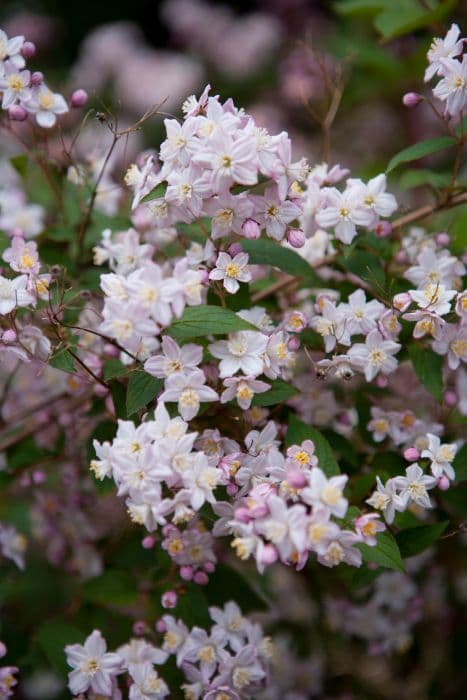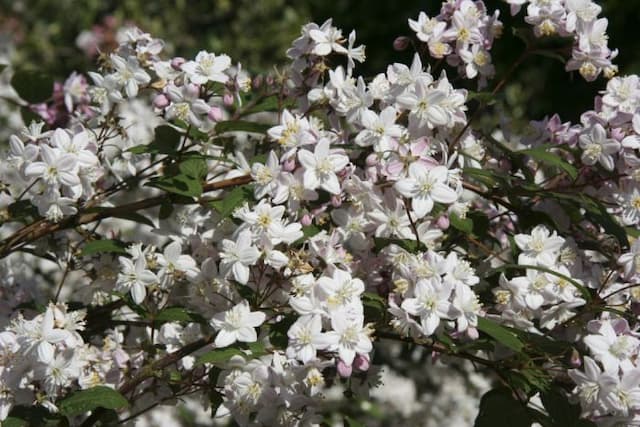Paniculate hydrangea Pink Diamond Hydrangea paniculata Pink Diamond = 'Interhydia'

ABOUT
[Pink Diamond] is a vigorous deciduous shrub with conical panicles of creamy white sterile and fertile flowers which age to a deep pink, borne from late summer into autumn
About this plant
 Names
NamesFamily
Hydrangeaceae
Synonyms
Pink Diamond Hydrangea, Panicled Hydrangea, Pink Diamond Hardy Hydrangea
Common names
Hydrangea paniculata 'Interhydia'.
 Characteristics
CharacteristicsLife cycle
Perennials
Foliage type
Deciduous
Color of leaves
Green
Flower color
Pink
Height
6-8 feet (1.8-2.4 meters)
Spread
6-8 feet (1.8-2.4 meters)
Plant type
Shrub
Hardiness zones
3-8
Native area
China, Japan
Benefits
 General Benefits
General Benefits- Aesthetic Appeal: The Pink Diamond Hydrangea adds visual interest to gardens with its striking pink blooms that fade to a lovely cream color.
- Landscape Versatility: It can be used in a variety of landscape designs, including borders, hedges, and as a focal point in garden beds.
- Pollinator-Friendly: The flowers attract pollinators such as bees and butterflies, contributing to the health of the local ecosystem.
- Seasonal Interest: It provides extended interest from mid-summer to fall with its long-lasting flowers and autumn foliage.
- Low Maintenance: Once established, it requires minimal care, making it a good choice for gardeners of all skill levels.
- Hardiness: This plant is hardy in various climates and can withstand cold temperatures, making it suitable for many gardens.
- Durability: It can tolerate urban pollution, making it a good option for city gardens and landscapes.
- Erosion Control: The Pink Diamond Hydrangea's root system helps to stabilize soil and control erosion on slopes.
 Medical Properties
Medical PropertiesThis plant is not used for medical purposes.
 Air-purifying Qualities
Air-purifying QualitiesThis plant is not specifically known for air purifying qualities.
 Other Uses
Other Uses- Photography Prop: Hydrangea paniculata 'Pink Diamond' with its large, attractive flower heads, can serve as an elegant backdrop or subject for botanical photography.
- Craft Material: Dried blooms of the Pink Diamond hydrangea can be used in floral arrangements, wreaths, and other craft projects, adding texture and a touch of nature to handmade items.
- Wedding Decor: The lush flowers of Pink Diamond hydrangeas can be incorporated into wedding bouquets, centerpieces, and venue decorations for a romantic theme.
- Culinary Garnish: While not edible, the blossoms can be used to decorate cakes and desserts for special occasions, provided they’re removed before eating.
- Plant Dye: The natural pigments in Pink Diamond hydrangea’s petals can be used to create a plant-based dye for fabrics or papers.
- Teaching Tool: This plant can be used in botany lessons for teaching about plant morphology, particularly the differences between types of inflorescences.
- Artistic Inspiration: The blooms of the Pink Diamond hydrangea can inspire artists, serving as subjects for painting, drawing, and other forms of visual art.
- Theater and Film: The shrubs can be used as part of stage or movie set design to create a believable and visually appealing natural environment or garden scene.
- Garden Photography Workshops: Hydrangea varieties like Pink Diamond are often subjects in garden and flower photography workshops, where students can practice macro and portrait style plant photography.
- Ephemeral Fashion: Live or dried flowers can be incorporated into high fashion designs or accessories, providing an organic and unique element to haute couture collections.
Interesting Facts
 Feng Shui
Feng ShuiThe Pink Diamond Hydrangea is not used in Feng Shui practice.
 Zodiac Sign Compitability
Zodiac Sign CompitabilityThe Pink Diamond Hydrangea is not used in astrology practice.
 Plant Symbolism
Plant Symbolism- Emotion - Hydrangeas often symbolize heartfelt and genuine emotions due to their luxurious and abundant flower heads.
- Gratitude - The Pink Diamond Hydrangea can be a symbol of gratitude, often given as a thank you gift.
- Understanding - This variety of hydrangea might reflect a deeper comprehension or understanding between people.
- Beauty - Recognized for their striking appearance, they can represent the beauty found in life’s diversity.
- Pride - Pink hydrangeas might denote feelings of pride, whether it be pride in achievements, or personal pride.
- Boastfulness - Hydrangeas can sometimes have a negative connotation of vanity or boastfulness, stemming from the showy nature of their blooms.
 Water
WaterPink Diamond Hydrangea should be watered thoroughly once a week, providing approximately 1 inch of water each time to ensure the soil is moistened to a depth of around 8 inches. During hot, dry periods, you may need to water two or three times per week. It's best to water early in the morning to allow the foliage to dry before nightfall, reducing the risk of fungal diseases. Always avoid overhead watering to prevent leaf diseases; instead, use a soaker hose or drip irrigation to deliver water directly to the root zone. Do not let the soil become completely dry, as this can stress the plant and lead to wilting.
 Light
LightPink Diamond Hydrangea thrives in full sun to partial shade, with ideally four to six hours of sunlight a day. Morning sun with dappled afternoon shade or filtered sunlight is preferable, as intense afternoon sun can cause scorching of the leaves in hotter climates. A spot that offers protection from strong winds will also help prevent damage to the blossoms.
 Temperature
TemperaturePink Diamond Hydrangea prefers temperatures between 65°F and 75°F for optimal growth. It can tolerate minimum winter temperatures down to around 40°F but is frost sensitive. Extended exposure to temperatures below freezing may damage or kill the plant. The ideal growing conditions involve avoiding temperature extremes, providing some protection if unexpected cold snaps occur.
 Pruning
PruningPink Diamond Hydrangea should be pruned to remove dead or weak stems and to shape the plant in late winter or early spring before new growth starts. Pruning encourages fresh growth, larger flowers, and helps maintain a manageable size. Remove about one-third of the oldest stems to rejuvenate the plant and enhance blooming potential. The best time for pruning is just as the plant becomes dormant or immediately after the last frost.
 Cleaning
CleaningAs needed
 Soil
SoilPink Diamond Hydrangea prefers well-draining, fertile soil with a peat-based mix. Incorporate organic matter like compost and ensure the soil pH is slightly acidic, around 5.5 to 6.5, for optimal growth.
 Repotting
RepottingPink Diamond Hydrangea doesn't need frequent repotting; it can be done every 3-5 years or when the plant outgrows its current container, primarily to refresh the soil and increase pot size.
 Humidity & Misting
Humidity & MistingPink Diamond Hydrangea thrives in moderate to high humidity levels. Aim for an environment with around 40-60% humidity for healthy growth and development.
 Suitable locations
Suitable locationsIndoor
Provide bright indirect light and keep soil moist.
Outdoor
Plant in partial sun, sheltered location, and well-draining soil.
Hardiness zone
3-8 USDA
 Life cycle
Life cycleHydrangea paniculata 'Pink Diamond' (often referred to as 'Pink Diamond' Hydrangea) begins its life cycle when a seed germinates, typically requiring stratification to break dormancy. Upon sprouting, the seedling develops into a juvenile plant, establishing a root system and growing its first leaves. As it matures, the plant enters a vegetative state where it focuses on leaf and stem growth, developing the sturdy framework necessary for supporting its large flower panicles. Following vegetative growth, it enters the reproductive phase, where buds form and bloom into the characteristic cone-shaped clusters of white flowers that gradually turn pink as they age. After the flowering period, the plant sets seed in the late summer or fall, completing the reproductive stage. The hydrangea then enters a period of dormancy during the winter, conserving energy and resources until the cycle begins anew with the return of warmer spring temperatures.
 Propogation
PropogationPropogation time
Early spring
Hydrangea paniculata 'Pink Diamond' is most commonly propagated through softwood cuttings. The best time to take these cuttings is in the late spring through early summer when the plant's new growth is still tender and flexible. Cut a 4 to 6-inch piece of stem from the shrub, making sure there are at least 2-3 pairs of leaves. Remove the leaves from the lower half of the cutting, and dip the cut end into a rooting hormone to encourage root development. The treated cutting should be planted in a mixture of peat and perlite, ensuring high humidity and consistent moisture while avoiding waterlogged conditions. In approximately 4-6 weeks, roots should have formed, at which point the new hydrangea cutting can be transplanted to a larger pot or directly outdoors if the weather permits.








![Hydrangea [Early Sensation]](/_next/image?url=https%3A%2F%2Fplants-admin.emdemapps.com%2Fimages%2Fplants%2F%2Fimages%2F604b6150338db.png&w=640&q=75)
